Stained Glass
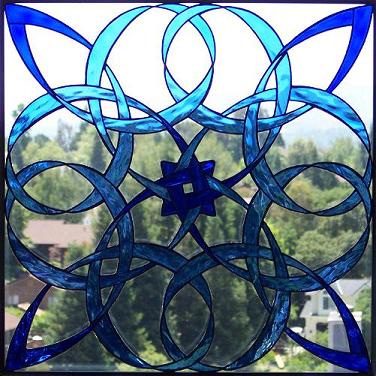 The term stained glass can refer to the material of colored glass or the craft of working with it. When referring to the
Material of StainGlass, it is any glass that has been colored by adding specific metallic oxides,
such as cobalt for blue, when the glass is in a molten state.
The term stained glass can refer to the material of colored glass or the craft of working with it. When referring to the
Material of StainGlass, it is any glass that has been colored by adding specific metallic oxides,
such as cobalt for blue, when the glass is in a molten state.
The Craft of Stained Glass is the art of arranging small pieces of colored glass to form patterns or pictures, held together (traditionally) by strips of lead and supported with a rigid zinc or wood frame. These pieces may or may not be enhance with special paints that are fused to the glass in a kiln.
The traditional definition of Cathedral glass encompasses all monochromatic sheet glass, which is thin (generally less than ¼ inch thick) by comparison with slab glass (more than ¾ inch thick). In historic times, all Cathedral glass was translucent. Most StainGlass windows are made exclusively with cathedral glass. However, other materials such as: beveled glass, marbles, rods, bottom of wine bottles or even flat river stones, can be incorporated into StainGlass windows.
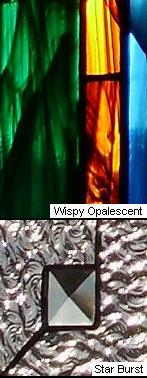
 In recent years, with the invention of opaque glass by John La Farge in 1880, the definition of Cathedral glass has
evolved to be all translucent monochromatic sheet glass. The Celtic Knot (upper-left) is made with Cathedral glass.
In recent years, with the invention of opaque glass by John La Farge in 1880, the definition of Cathedral glass has
evolved to be all translucent monochromatic sheet glass. The Celtic Knot (upper-left) is made with Cathedral glass.
Opalescent glass, as the name implies, is any glass that is opaque or semi-opaque. Tiffany created many hybrids using a combination of cathedral and opalescent glass. The most common types are called Steamer, Fracture and Ring Mottle. Since that time, a huge selection of glass has been developed with more generic names such as Wispy and Streaky.
An important trait of glass, with respect to the transmission of light, is Texture. There is a wide ranges of textures, from seedy (the inclusion of small air bubbles) to rippled (like the surface of a lake). Textures cause the angle of light to change as one walks by, creating the appearance that the art is alive! Textured glass, in direct sunlight, often has a sparkle; for indirect light, the effect can be wavy, flowing. The glass in the Celtic-Knot (above) is made with two shades of blue Cathedral glass that has a texture called Waterglass. The example to the far right is a pink Cathedral glass with a texture called Star Burst.
Fused Glass
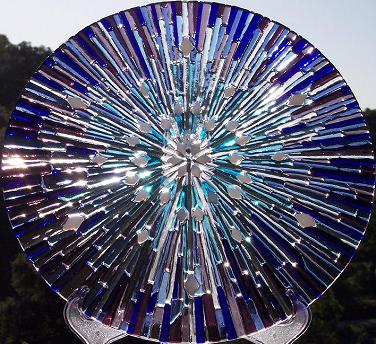 The Craft of Fused Glass is the art of combining glass of different colors and opacity to achieve more detail and to
create multi-layered designs. The different colors and layers of glass are melted in a kiln at temperatures up to 1465 degrees Fahrenheit. All fused
glass must be tested for the same coefficient of expansion (COE), or the glass will cialis vs levitra crack due to stress created at the fused boundary of the different
COE glasses. This makes the craft of fused glass more expensive!
The Craft of Fused Glass is the art of combining glass of different colors and opacity to achieve more detail and to
create multi-layered designs. The different colors and layers of glass are melted in a kiln at temperatures up to 1465 degrees Fahrenheit. All fused
glass must be tested for the same coefficient of expansion (COE), or the glass will cialis vs levitra crack due to stress created at the fused boundary of the different
COE glasses. This makes the craft of fused glass more expensive!
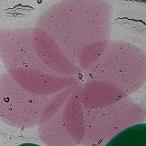 Different affects can be achieved by fusing the glass at different temperatures. Full Fuse is achieved at the highest
temperature. With the Kiln programed to reach 1465 degrees, stacked layers of glass melt together to form a flat surface. Stacking cathedral glass
can convert two colors into three. For example, layering cathedral blue on cathedral green creates teal. Fusing the same color together creates
shadows, as in the over lapping petals of this Amaryllis.
Different affects can be achieved by fusing the glass at different temperatures. Full Fuse is achieved at the highest
temperature. With the Kiln programed to reach 1465 degrees, stacked layers of glass melt together to form a flat surface. Stacking cathedral glass
can convert two colors into three. For example, layering cathedral blue on cathedral green creates teal. Fusing the same color together creates
shadows, as in the over lapping petals of this Amaryllis.
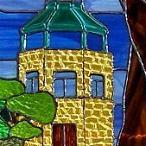 Tac Fuse starts at 1325 degrees and can range up to 1400 degrees. In this temperature range stacked glass are bonded
together, but still retain their edges; the cooler the temperature, the shaper the edge. At a tac fuse temperature, textured glass can be customized.
The example to the right, uses a tac fused temperature to simulate the stone building. The example above is also fired at a tac fuse.
Tac Fuse starts at 1325 degrees and can range up to 1400 degrees. In this temperature range stacked glass are bonded
together, but still retain their edges; the cooler the temperature, the shaper the edge. At a tac fuse temperature, textured glass can be customized.
The example to the right, uses a tac fused temperature to simulate the stone building. The example above is also fired at a tac fuse.
Slumping starts at the lowest temperature and requires a ceramic mold. The glass is placed on top of a mold and fired to a temperature in the range of 1225 to 1300 degrees. At these temperatures glass "slumps" to the shape of the supporting mold. With molds the artist can create glass plates and bowls. To create cups and narrow neck bottles, requires a glassblower furnurance that can reach temperatures of 2400 degrees.
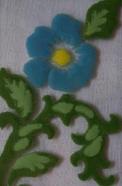
Another common technique used is Glass Enameling. This technique uses finely ground colored glass. The glass powder
is typically sifted onto a clear glass surface and full fused. Often stencils are used to create a pattern with the glass powders before fusing.
The processes can be repeated with different glass powders. The example to the left required four glass powders and two firings in the kiln. It was
incorported into stain glass window: "Interlocking Squares with Pansies". The album cover on the right, uses multiple techniques, including a glass enamel
silhouette of a cyclist.